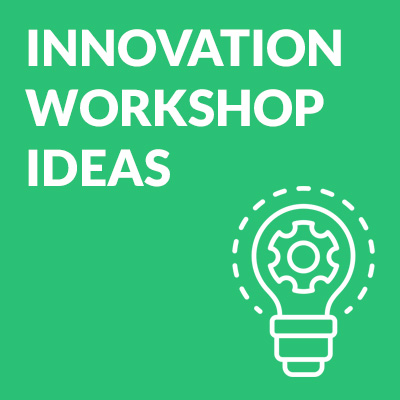 Joining an innovation workshop is a big ask.
Joining an innovation workshop is a big ask.
Your colleagues are busy so you need to make sure everything goes well.
How?
In these reflections, you’ll find out about useful activities that will help you design a successful innovation workshop.
4 activities to start your innovation workshop
The start of an innovation workshop is a chance to set the tone for the day.
How?
At this moment, you can remind the participants about:
- Why they’re in the room
- What they’re going to do
- What the workshop will feel like
- How you want them to behave
Let’s dig into activities that will help you do that.
1. Objectives

Purpose:
When you clarify the objectives of the session, you allow the participants to understand why the workshop is important and how it relates to their day-to-day work.
It’s a way to make sure everyone is engaged.
How it works:
There are two categories of objectives:
- The high-level objectives
These are the context and vision for the overall project. They give the participants reasons to be in the room with you. - The direct objectives
These are the expected results and outputs of the session. It’s what you will have achieved as a group by the end of the innovation workshop
2. The Agenda
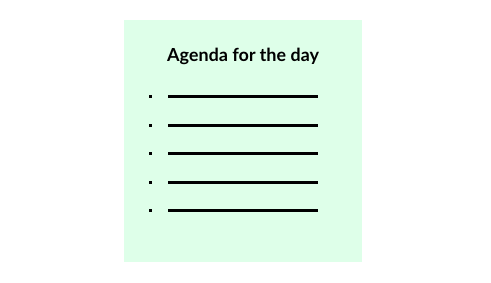
Purpose:
It’s important for participants to have access to the agenda for the workshop. It allows them to relax as they can anticipate what’s coming next.
How it works:
From my experience, there’s something that works well:
- Share an outline agenda ahead of the workshop (when you invite the participants).
- And then, introduce a more detailed agenda at the beginning of the session.
Print it or draw it on a large sheet of paper so you can put it in a place where everyone can see it during the whole workshop.
Bonus if you can give them the exact timings and indicate when the breaks will happen.
As Roger Schwartz wrote in HBR:
“The estimated time enables team members to either adapt their comments to fit within the allotted timeframe or to suggest that more time may be needed.”
It helps the participants plan the workshop in their head and see the relative importance of each activity/topic.
3. Group Agreements
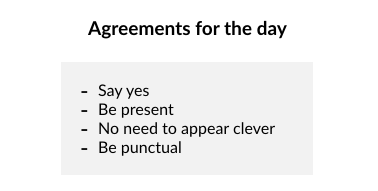
Purpose:
Group agreements help you set the tone by telling your audience how you want them to behave during the innovation workshop.
How it works:
You want to share agreements that are relevant for your workshop.
Here are some ideas:
- Say yes
Not everything maybe 100% on point for you, open yourself to it and build on it. - Be present
Stay away from distractions, e.g. don’t use your phone or computer during the workshop. - No need to appear clever
Avoid asking the “smart” question if it doesn’t contribute to anything. - Be punctual
This is a polite way to tell the participants that time is tight and it’s possible that we end a discussion because we need to move on to something else.
I think it’s faster if you share how you want people to be in the room and get them to agree.
But some facilitators suggest to get the group to create their own set agreements. (Caveat: it takes a lot of time for very little impact.)
4. The Parking Lot
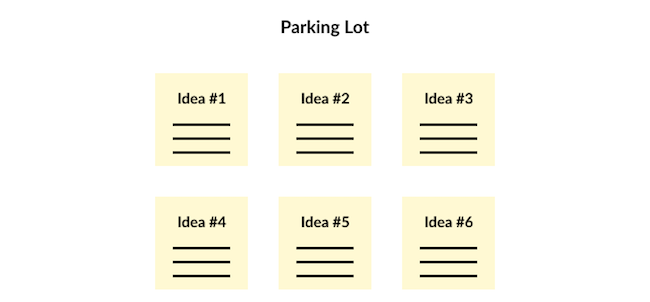
Purpose:
Having a Parking Lot is really useful when you want to keep the group focused on a topic.
It allows to avoid distracting or interrupting the flow with something that is off-topic at the moment.
How it works:
You allocate a space on a wall to “park” ideas or questions that do not relate with what the group is working at a specific time.
For example, the first phase of your innovation workshop is about reviewing the customer journeys of your target market.
A Parking Lot is useful to keep the ideas people may have while focusing on the customer journeys. Therefore, they won’t interrupt the flow by sharing their ideas with the rest of the group.
Ideas of exercises for your innovation workshop
There are many exercises that be done during an innovation workshop.
It really depends on what you want to achieve.
Here are some examples:
- Defining your current challenges
- Understanding your customers better
- Reviewing a new innovation process
- Generating new ideas
- Deciding on the next phase of a project
Now let’s dive into more detailed exercises.
Co-creating a Customer Journey
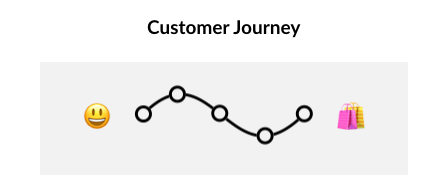
Purpose:
A good exercise for an innovation workshop is co-creating customer journeys.
Indeed, it’s helpful to leverage the expertise you have in the room to map the different journeys your customers go through.
How it works:
First, you need to pick the segments of customers you want to focus on.
In the room:
- You need a lot of space. A big wall would be great.
- Then, get a group of 3-5 participants to create the customer journey of a specific segment.
- They can use Post-it notes to indicate each step, the touch-points with your company, and (if you have the data) how the customers feel at each step.
- Finally, get the group to share back and ask the rest of the participants to build on the journey.
For more information about creating a customer journey, read these reflections.
A good book: If you want to get into more detail than what a blog post can share, I recommend you The Workshop Survival Guide by Rob Fitzpatrick.
How to end your innovation workshop on a high note
At the end of an innovation workshop, you want the energy to be high.
There’s a psychological reason to it:
The peak-end rule.
“It’s a psychological heuristic in which people judge an experience largely based on how they felt at its peak (i.e., its most intense point) and at its end, rather than based on the total sum or average of every moment of the experience.”
Here are two exercises to leverage it.
1. Reflections
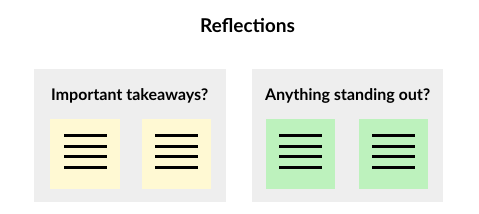
Purpose:
Having the group share reflections at the end of an innovation workshop is a good way to finish on a high note and emphasise the positives.
How it works:
There are many ways to set this exercise.
Here’s one:
- Have the participants work in pairs.
- Ask them to write on Post-it notes any important takeaways or anything that stood out.
- Then, get each pair to share back with the rest of the group.
As a facilitator, you should try to categorise the reflections to reinforce what is being said.
2. Next Steps: Actions and Ownership
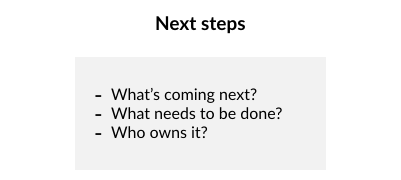
Purpose:
Capturing the next steps allow you to make sure that you will keep the momentum after your innovation workshop.
How it works:
It really depends on how things are organised.
Sometimes, all the facilitator will own all the tasks. In other cases, the ownership is divided between some participants.
But it’s important to answer the following three questions:
- What’s coming next?
Remind the participants of the next milestones for your strategy/innovation project. - What needs to be done?
Clarify what tasks will be done and their deadlines. - Who owns it?
Make sure that each task is clear and has an owner who’s committed to making it happen.
You’re about to organise a workshop?
Read these reflections about how to run a great workshop.
A good book: If you want to get into more detail than what a blog post can share, I recommend you The Workshop Survival Guide by Rob Fitzpatrick.